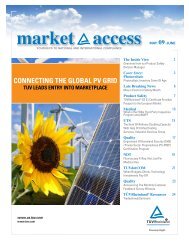FITNESS EQUIPMENT STANDARDS
FITNESS EQUIPMENT STANDARDS
FITNESS EQUIPMENT STANDARDS
Create successful ePaper yourself
Turn your PDF publications into a flip-book with our unique Google optimized e-Paper software.
MAY/JUNE 2005<br />
Q: How do I know if my<br />
product falls within the<br />
parameters of the Pressure<br />
Equipment Directive<br />
(97/23/EC)?<br />
A: The PED applies to pressure<br />
equipment (vessels, piping, pressure<br />
accessories), safety accessories or<br />
assemblies with a maximum allowable<br />
pressure (PS) greater than 0.5 Bar (7.25<br />
psi). Manufacturers or assemblers of<br />
pressure equipment above this pressure<br />
must review the requirements of the<br />
directive to determine if their products fall<br />
under the directive. In determining the<br />
category of the product, the fluid and<br />
volume (vessels) or nominal size DN<br />
(piping) must be considered. The fluid (e.g.<br />
gases, liquids, vapors) in combination with<br />
the pressure will determine the applicable<br />
category. Depending on the product of the<br />
PS x Volume/DN, and the fluid, a product<br />
Category<br />
Art.3.3<br />
I<br />
II<br />
III<br />
IV<br />
NB required?<br />
Outside Scope of PED<br />
No<br />
QA + Surveillance<br />
Type or Design<br />
Examination and<br />
Surveillance by NB or QA<br />
Approval<br />
Type Examination and<br />
Verification by NB or QA<br />
Approval (+ add.<br />
requirements)<br />
(e.g. H1 Design Exam)<br />
8 A PUBLICATION OF THE TÜV RHEINLAND GROUP<br />
TUV Rheinland of North America, Inc. invites you to ask the experts. Your questions can<br />
pertain to anything that you want to know about product testing and certification services<br />
regarding Automotive, EMC, Ergonomics, Field Evaluation, Industrial Machinery,<br />
Management Systems, Medical, Pressure Equipment, Product Safety and Telecom. Please<br />
check back each issue to find out what questions have been answered.<br />
Please submit questions to tconroy@us.tuv.com and write in the subject line “Ask the Experts.”<br />
will be classified as Sound Engineering<br />
Practice SEP (no CE Marking allowed),<br />
Category I, II, III or IV. The lower the<br />
category, the less mandated involvement<br />
by a Notified Body.<br />
(Please refer to chart below.)<br />
Q: How do I pick the proper<br />
PED (97/23/EC) Conformity<br />
Assessment Module for my<br />
product?<br />
A: The first step to evaluating the best<br />
choice of modules is to properly categorize<br />
the product. Under the PED, products and<br />
systems are reviewed, approved and/or<br />
monitored on a regular basis. Module<br />
choice is based on category, and the<br />
choice of modules can be impacted by<br />
several variables: 1) Category; 2)<br />
Production Schedule (e.g. one-of-a-kind<br />
vs. serial); and 3) Quality System.<br />
A<br />
Modules<br />
A1 D1 E1<br />
B1+D B1+F B+E B+C1 H<br />
B+D B+F G H1<br />
Q: Can I use the ASME Code<br />
to satisfy the Essential<br />
Safety Requirements (ESR)<br />
of the Pressure Equipment<br />
Directive (PED)?<br />
A: Yes. Manufacturers that use the ASME<br />
Code have to prove that the pressure<br />
equipment complies with the Essential<br />
Safety Requirements (ESR). Additional<br />
requirements to ensure compliance with<br />
PED also have to be met:<br />
Proof Test – A basic of 1.43 times its<br />
Maximum Allowable Working Pressure<br />
has to be met.<br />
Stability – The respective loads for wind,<br />
snow, earthquake, etc., as well as special<br />
building regulations have to be considered.<br />
Operating Instructions – Operating<br />
instructions should be available at the time<br />
of the design approval and must be<br />
evaluated by the Notified Body.<br />
Hazard Analysis – The manufacturer is<br />
obliged to accomplish a hazard analysis.<br />
The hazard analysis shall include the<br />
following:<br />
• Identification of hazards due to<br />
pressure<br />
• Elimination or reduction of hazards<br />
• Protection measures<br />
• Means of examination<br />
• Means of draining and venting<br />
• Corrosion or other chemical attack<br />
• Wear<br />
• Assemblies<br />
• Provisions for filling and discharge<br />
• Protection against exceeding the<br />
allowable limits<br />
• Safety accessories<br />
• External fire













